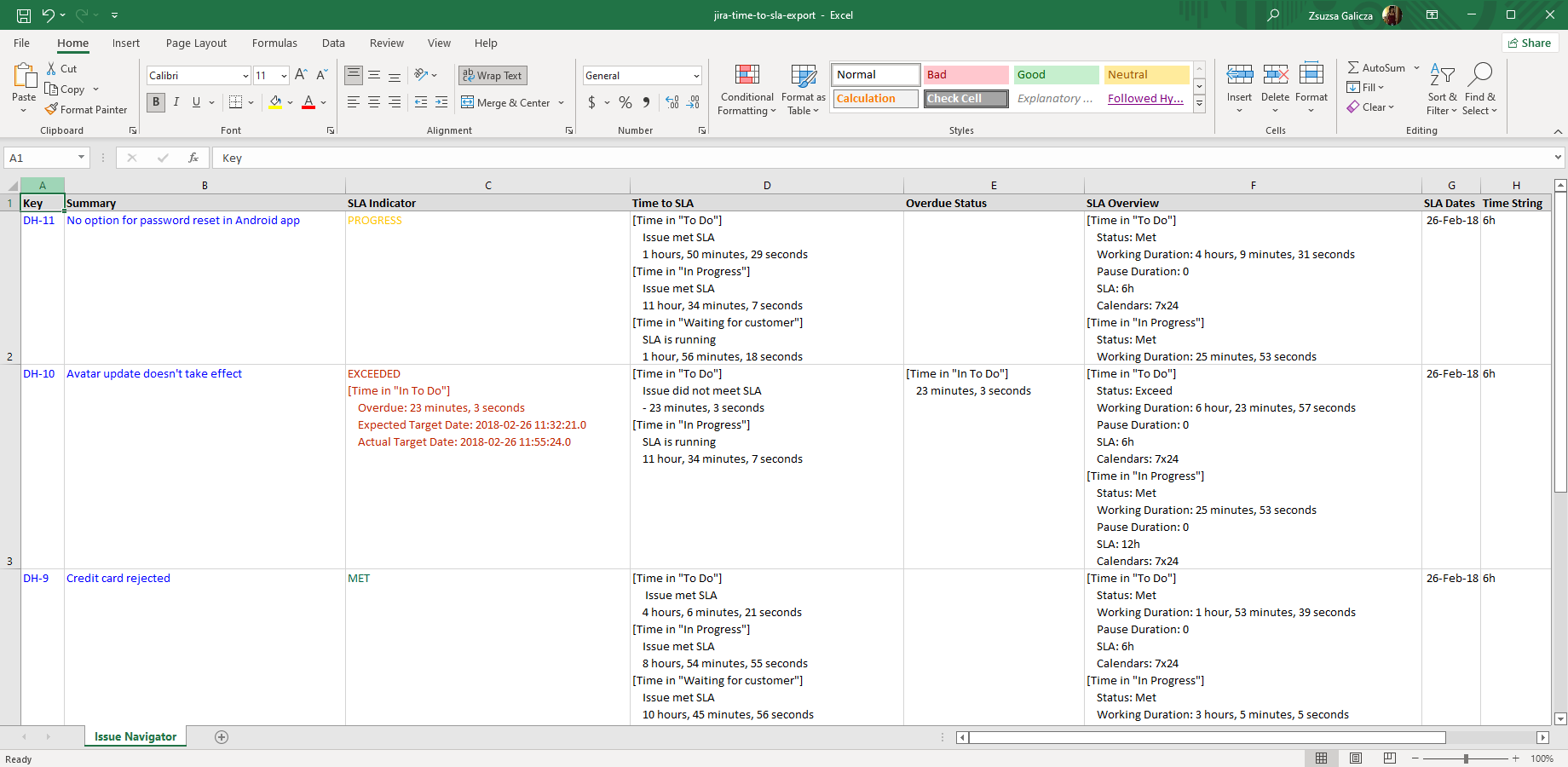In this page
Time to SLA integration features
Time to SLA integration vs. the Time to SLA built-in Excel exports
Tutorial video
Time to SLA Excel export samples
Jira issues with Time to SLA fields
Configuration
Configuring the Time to SLA custom fields
Configuring the export format for the Time to SLA custom fields
Learn more about Time to SLA
What is Time to SLA?
(supported since Better Excel Exporter 3.4.0)
Time to SLA is a popular choice to implement Service Level Agreements (SLAs) on Jira issues. It helps to set up, track and measure SLAs based on issue events (status change, resolution, reopen, etc.).
Time to SLA integration features
- You can export the Time to SLA specific custom field types like Time to SLA, Overdue Status, SLA Indicator, SLA Overview, TTS - Time String and TTS - SLA Dates to Excel.
(Need more features? Tell us in a support ticket!)
Time to SLA integration vs. the Time to SLA built-in Excel exports
You may want to ask: if Time to SLA has a built-in Excel export feature, why would you use another app for the same?
While the Time to SLA built-in Excel exports may be sufficient for basic use cases, the Better Excel Exporter integration is more powerful in, at least, these:
-
It supports Excel automation.
You can export, email and attach Excel files using Automation for Jira (visual automation rules), ScriptRunner (Groovy scripts), or the REST API (use your favorite language!). -
It is extremely customizable.
Instead of accepting the pre-defined export types in Time to SLA, you can define your own types via Excel templates. -
It supports all the powerful Excel features.
You can use Excel formulas and functions, custom calculations in Groovy (sorting, complex math, data integration, etc.), charts, pivot tables, pivot charts, Visual Basic macros, among others. -
It is integrated with all the popular Jira apps.
You can freely combine Time to SLA data and other apps' data in the same Excel file. -
It comes with powerful templates optimized for Time to SLA.
You can use those "as is", or customize them to your needs. - It is well-documented with the customization guide, the Expression Reference Manual, the recipes, and such.
If at least one of these is important for you, give the app a try.
Tutorial video
This short video shows how simple it is to export Time to SLA data to Excel:
Time to SLA Excel export samples
Jira issues with Time to SLA fields
This basic Excel export (created using the default issue-navigator.xlsx template) contains one column of each Time to SLA custom field type. The idea is to demonstrate the default SLA export format that you can customize to your needs.
Configuration
Configuring the Time to SLA custom fields
There is nothing to do. Better Excel Exporter will automatically recognize the Time to SLA managed fields and export them accordingly.
Configuring the export format for the Time to SLA custom fields
While some Time to SLA custom fields display simple values (like a single date), some others display fairly complex ones (like a complete SLA history). Complex values are exported to Excel cells using the structured left-indented text format that we found the most intuitive:
[Time in "To Do"] Issue met SLA 1 hours, 50 minutes, 29 seconds [Time in "In Progress"] Issue met SLA 11 hour, 34 minutes, 7 seconds [Time in "Waiting for customer"] SLA is running 1 hour, 56 minutes, 18 seconds
You can freely customize the output format by modifying these methods in the field-helper-tool.groovy script:
// field-helper-tool.groovy private def overdueStatusToString(def ttsFieldValue) private def slaIndicatorToString(def ttsFieldValue) private def slaOverviewToString(def ttsFieldValue) private def timeToSlaToString(def ttsFieldValue)
Not only you can use and modify the information you can see in the original implementation of these methods, you can also access additional information. Those are specific to the custom field type.
For example, to display the time in milliseconds for the Time to SLA custom field values, change the it.timeToSlaAsString expression to it.timeToSla in the timeToSlaToString() method. For a comprehensive guide, please refer to the official Time to SLA developer documentation
Learn more about Time to SLA
- Time to SLA product information (at its own vendor)
- Time to SLA documentation
- Time to SLA app page (on the Atlassian Marketplace)




